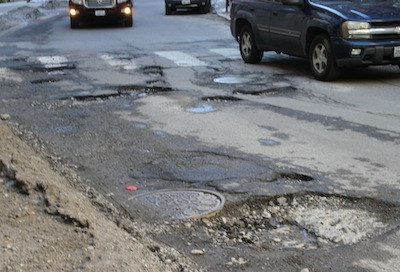Providence Report Unveils Devastating Finances; Former Council Pres. Calls Elorza “Divisive”
Tuesday, April 12, 2016
The City of Providence is facing a budget deficit that is projected to balloon over 1100% in ten years according to a new report — and former City Council President Michael Solomon is calling out Providence Mayor Jorge Elorza for placing the blame on his predecessors.
The "Ten Year" report, conducted by consultant group The National Resource Network, shows this coming fiscal year’s budget deficit as being $3 million -- and rising up to over $37 million in Fiscal Year 2026.
SLIDES: See Ten Big Budget Challenges Facing Providence in Next Ten Years BELOW (Fiscal Year 2017 - Fiscal Year 2026)
GET THE LATEST BREAKING NEWS HERE -- SIGN UP FOR GOLOCAL FREE DAILY EBLAST“The City is already operating with a negative fund balance. If no corrective action is taken, the City will inevitably face cash flow challenges, an inability to invest in priorities, and the need to further reduce services and increase taxes,” wrote The Network. “Providence faces the prospect of additional rating agency credit downgrades, increased debt issuance costs, and limited access to capital markets. In fact, the longer it takes for the City to acknowledge and confront its fiscal challenges, the harder and more painful it will become to implement viable solutions."
Elorza, who is slated to issue his second budget proposal later this month for the coming fiscal year, said the challenges didn’t appear 'overnight'.
“The way the city currently budgets rewards short-term thinking and forces us to scramble for one time fixes instead of focusing on the investments we need to succeed,” said Mayor Elorza. “These challenges did not develop overnight but, rather, are the result of decades in a system that looks to one-time fixes and makes it difficult if not impossible to budget for two, five or even ten years ahead.”
SLIDES: Read the Full Report HERE
Solomon, who ran for Mayor in 2014 after serving as City Council President for four years, took issue with Elorza's claims.
“I would like to see the Mayor substantiate his comments concerning decades of neglect with respect to the last five years,” said Solomon. “I was proud to stand shoulder-to-shoulder with Mayor Taveras to rein in an incomprehensible $110 million structural deficit. We emphasized teamwork and crafted solutions with tenacity. In four years, we passed a national model for retiree pension reform, achieved nearly $40 million in new payments from our tax exempt institutions, and successfully lobbied state officials for an increase in state aid – to name a few. Perhaps the Mayor should take a page out of our playbook and choose to work with city stakeholders - such as our brave firefighters - instead of playing the divisive politics of the past.”
Solomon is speculated to be eyeing a run for Mayor again in 2018, but declined to comment on Monday.
Council on the Record
The analysis put forth by the consulting group stipulates that the “projected savings from PFD call back savings are not included baseline projection due to the ongoing legal proceedings.”
Elorza had announced the contested platoon shift change last May with the intention of saving $5 million; overtime costs soared as a result of the move.
“The budget is a result of lack of due diligence and hasty decisions, especially around the fire department,” said City Councilman David Salvatore. “It's clear that the reduction of platoons was not the answer. Anyone with any expertise would say the minimum manning number is driving the overtime costs. Our biggest issues are legacy costs and the overtime costs.”
City Council President Luis Aponte said that the consultant report on fire department staffing, which was commissioned in December, is expected shortly.
“There are a lot of externals we need to be aware of, both with the litigation and if there’s a settlement, so what that price tag would be in an unknown. Our legislative approach and the state aid that we get should be factored in,” said Aponte. “ I thought this report is a useful tool for benchmarks that go beyond electoral terms, but we need to remember that our budgets are dynamic.
Aponte spoke to what he said were the surprises in the report.
“One of the concerns to me is that we have to maintain more mileage than other cities our size, which brought into light our infrastructure challenges and need for bettering our roads, bridges, and sidewalks,” said Aponte. “At what point do we consider investing and not waiting for when everything falls apart?”
“The other part of this report is to examine the principles that direct and inform the budget. Our schools buildings, they are in difficult shape due to deferred maintenance. Our pension, it's been the victim of less than required contributions,” said Aponte. “I think it becomes that there are so many competing priorities for budget dollars -- libraries, schools recreations centers — so the question is how this [report] can hopefully help us establish where we want to be in these areas, and make incremental progress towards a goal.”
Main Photo: Flickr/AlexDrainville
Related Slideshow: 2016 Providence Benchmark Report - Ten Big Takeaways
Related Articles
- GoLocal Denied Entrance to Providence Panhandling Meeting
- Tracey Minkin Headlines WORKSHOP-PALOOZA! The Writing Worshop Hits Providence April 23rd
- Country Musician Chris Carpenter to Perform at Renaissance Providence April 7
- Rescuing Providence: Part 1 - 1036 Hours Through 1339 Hours, a Book by Michael Morse
- Rescuing Providence: Part 1 - 0800 Hours Through 0840 Hours, a Book by Michael Morse
- Former Providence Mayor Paolino Takes on Elorza Over Panhandling Policy
- Providence’s $1 Million Tax Increase Causes Teppco to Close—36 Jobs Lost
- Providence’s Nonprofits Face Diminished Dexter Donation Fund in 2016
- Providence Ranks 4th in US for Sweet Tooths
- South Side Residents Frustrated with 311 Response from City of Providence
- Providence Will Not Install Parking Meters on Hope St., No Word on Other Neighborhoods
- City of Providence Refuses to Answer Key Questions on Teppco’s Closure
- Providence Issues Parking Ban, After City Gets Hit with Half Foot of Snow
- Providence School Board Names Next Superintendent
- Rescuing Providence: Part 1 - 1355 Hours Through 1646 Hours, a Book by Michael Morse
- Providence Parking Meters Can’t Fund Millions in Deficits and Billions in Unfunded Liabilities
- Riley: Wainwright Issues Cash Flow Report That Points to Providence Asset Fraud
- Providence Merchants United in Outrage Over Parking Meter Expansion
- NEW: Bernie Sanders Campaign to Open Providence Office on Sunday
- NEW: Stray Baby Goat Found in Providence















